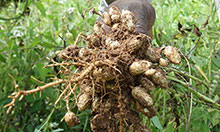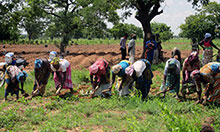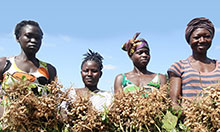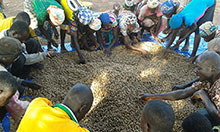Experience from the SPRING Project
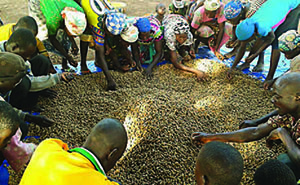
Since 2015, SPRING has worked in Ghana to reduce stunting and anemia among children under 5 and women of reproductive age. We cover 15 districts, 405 communities, and 280 health facilities in the Northern and Upper East Regions of Ghana.
We aim to (1) improve the delivery of high-impact nutrition services, (2) increase the demand for nutrition practices and services across sectors, (3) improve the enabling environment for nutrition, (4) improve the evidence base for delivery of selected high-impact interventions, and (5) enhance the policy environment for the delivery of district-level nutrition interventions.
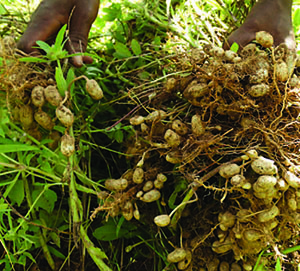
Good Practices Yield Good Results
Mrs. Amina Woyom of Gushegu District is 40 years old with five children, and is one of 50 farmers from her community to learn about good agronomic practices and post-harvest management from SPRING-sponsored Farmer Field Schools. After applying her new knowledge, within the first year she increased her groundnut yield from 123 kg/acre to 328 kg/acre.
She said, “Today I am the best woman farmer because I have adopted the best practices the Agric. Officers taught us. People visit my farm to see what I am doing, which made me very proud. I know that by next year, many women will surprise SPRING and Department of Agriculture because they have seen the evidence in me. In actual fact, we did not know the effect of using bad seeds. But SPRING has opened our eyes. Thank you SPRING for helping us save our families.”
Introduction: Why aflatoxin?
Food safety is an underlying driver of undernutrition. Unsafe foods lead to disease and chronic conditions that prevent the body from properly absorbing food nutrients (Ruel et al. 2013). SPRING/Ghana takes a multi-sectoral approach, simultaneously addressing both the direct and underlying causes of malnutrition.
Aflatoxins are toxic compounds produced by the molds Aspergillus flavus and/or Aspergillus parasiticus, and are common contaminants in maize and groundnuts. The fungi that produce these toxins thrive when grains or groundnut pods suffer insect or mechanical damage in the field, are harvested late, not sorted properly, and/or are improperly dried. Aflatoxins can cause immune-system suppression, gastrointestinal dysfunction, growth retardation, liver disease, and cancer (Williams et al. 2004).
Groundnuts are a staple legume in the northern regions of Ghana. SPRING/Ghana focuses on reducing aflatoxin contamination in groundnuts as a means to reducing chronic exposure to this toxin, which contributes to stunting and anemia during the 1,000-day period between pregnancy and a child’s second birthday.
Why groundnuts?
Groundnuts are an important staple and source of protein for Ghanaian households. If processed and stored properly, groundnuts provide the household with a year-round supply of a nutrient-rich food, and offer women an important store of value and source of income.
As is traditional in many parts of Africa, women in northern Ghana produce, process, and sell groundnuts from their homes. Most women plant, harvest, process, and store groundnuts for their family’s consumption, and sell from their stocks for income to cover expenses. Most agricultural extension services have overlooked this commodity in favor of cash crops such as rice, maize, and soybeans. As a result, the technologies, inputs, and practices employed for groundnut production and processing in northern Ghana have lagged relative to other crops, and are in need of upgrades.
Women directly benefit from the potential productivity and income increases resulting from SPRING’s interventions. These interventions also have a positive effect on the health and nutrition of mothers and their children.
Identifying an Appropriate Extension Approach for Women Farmers
Early in the project, SPRING recognized the need for women-centered training that catered to women’s needs. Therefore, training was offered in 60-90 minute segments, scheduled when most convenient to women, used appropriate language and relatable illustrative examples, and provided training modules that were adaptable to women’s other endeavors.
These endeavors included mother-to-mother support groups, village savings and loan association (VSLA) meetings, and health-related activities such as child welfare clinics and antenatal care.
When working with pregnant women and mothers of children under the age of 2, SPRING uses short, frequent engagements with Farm Field School (FFS) trainees.
We adopt a discovery-based learning approach within existing women’s groups, incorporating adult learning techniques such as observation-reflection-personalization-action (ORPA) and appropriate analogies. These techniques are most effective when they are part of an FFS curriculum, which leads women to learn by working on their farms throughout the production season.
Each learning session is facilitated by FFS curriculum trained Agriculture Extension Agents (AEAs) and focuses on a few key messages and on practical information that is immediately useful.
The learning agenda focuses on nutrition-sensitive outcomes that complement nutrition-specific modules from the Infant and Young Child Feeding (IYCF) package. Sessions emphasize environmental safety, sanitation, and food safety. Where appropriate, AEAs integrate stories and narratives that highlight critical nutrition and water, sanitation, and hygiene (WASH) behaviors, such as hand washing with soap, avoiding contamination with animal waste, and providing clean play spaces for children.
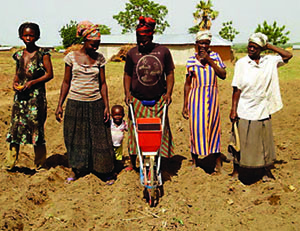
Objectives of the Farmer Field Schools for Groundnut Farmers
- Provide an environment in which farmers acquire the knowledge and skills to be able to make sound crop management decisions.
- Sharpen farmers’ abilities to make critical and informed decisions that make their farming activities more profitable and sustainable.
- Improve farmers’ problem-solving abilities.
- Show farmers the benefits of working in groups and encourage group activities.
- Empower farmers to become “experts” on their own farms and to be more confident in solving their own problems.
Reinforcing Messages Through Various Media
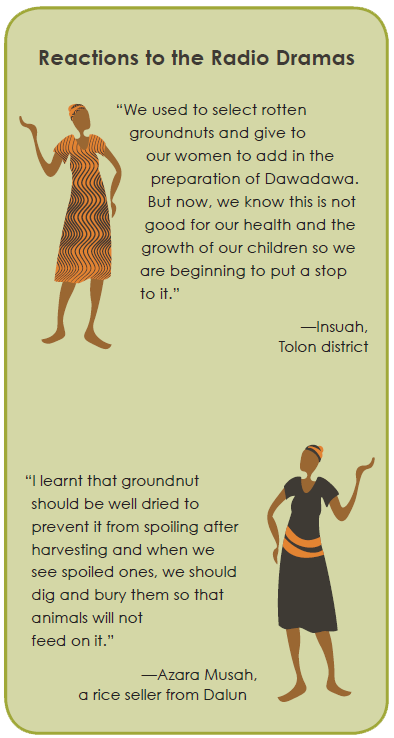
SPRING complements the discovery-based, learning-by-doing training approach with various communications materials that reinforce the lessons taught in Farmer Field Schools.
Video drama
SPRING engaged local drama troupes to produce a video—available in five local languages—that raises awareness of the dangers of aflatoxin contamination. The actors reinforce messages on good agricultural practices to prevent contamination, such as proper drying and sorting of groundnuts. The video models other positive behaviors such as distributing workload in the household (especially for pregnant and lactating women) by demonstrating male engagement in caregiving. Environmental sanitation, safety, hygiene, and food safety messages are also incorporated. Using a video ensures that consistent messages are delivered to all audiences. To ensure broad viewership, the video was made in the local language, and was shown in the evening, when communities were ready for entertainment.
The aflatoxin community drama videos were viewed by a total of 13,648 people (6,143 men and 7,505 women) in 105 communities. The videos reinforced, motivated, and encouraged good aflatoxin management practices. After each screening, participants engaged in a discussion led by a trained facilitator. After viewing the videos, community members were able to identify the role individuals could play to prevent aflatoxin contamination of groundnuts.
Radio dramas
We organized two 5-minute segments of a dramatized conversation and delivered it on 8 FM radio stations with good coverage and listenership in 15 SPRING-supported districts. The conversation revolved around good agronomic practices (GAP) and aflatoxin awareness. The radio segments were delivered in the appropriate local languages.
A total of 385 broadcasts on recommended practices meant to minimize aflatoxin contamination were aired continuously over the two-month planting period. Another 375 broadcasts about harvesting, storage, and utilization behaviors were aired across 8 local stations.
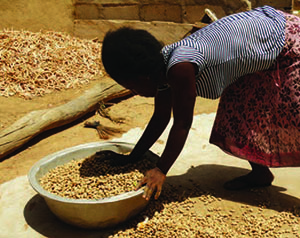
Farmer Field School Topics for Groundnuts
- Pre-harvest: site selection, land preparation, seed selection, germination test, planting, weeds/pest/disease control, aflatoxins.
- Harvest and post-harvest: harvesting, drying, sorting, bagging and storage; shelling, sorting, processing, and packaging; aflatoxin mitigation through all steps.
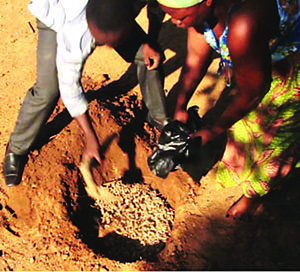
Safe Disposal of Bad Groundnuts
Households may be reluctant to dispose of bad groundnuts after they have been harvested and sorted, and often try to save unmarketable groundnuts by keeping them for home consumption, or feeding them to animals. This is counterproductive to health and nutrition as the rejected groundnuts have a high risk of aflatoxin contamination, which persists through the food chain.
In the video drama, SPRING included a demonstration of proper disposal of bad groundnuts (by burning or burying them) to reinforce a key message of food safety— disposing of bad groundnuts keeps family members healthy.
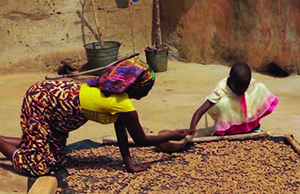
Proper Drying and Sorting
Working with researchers from the University for Development Studies in Tamale, Northern Region, SPRING collected groundnut samples from 51 households in 6 districts for aflatoxin testing. We collected samples 4 times over 7 months to detect any variation over the seasons while the groundnuts were in storage. We then compared testing results against the production and post-harvest practices adopted by each farmer.
Nine households (2 control, 7 treatment) out of the 51 households tested positive, above the threshold of 20 parts per billion (ppb), representing 8.7 percent of all samples taken. The following practices likely accounted for the contamination:
- Inability of farmers to use clean sheets for drying
- Not sorting out bad nuts before storage.
Although all the recommended agricultural practices are important, these two practices may be the most effective way to reduce the risk of aflatoxin contamination.
Photo aids
We developed a visual aid for use by AEAs to supplement and reinforce the information contained in the FFS Curriculum. The aid covers processes from pre-harvest through harvest and post-harvest to demonstrate best practices for producing, processing, storing, and transporting groundnuts.
Video on good agronomic practices
We reinforced the messages on best practices to reduce aflatoxin contamination by producing a brief 12-minute video that illustrated the steps identified in the FFS manual. The video reviewed the lessons covered throughout the year, and we showed it to women farmers. The AEAs used the video and the associated facilitation guide to summarize the essential points from the FFS training.
Reinforcing Messages Through Equipment Distribution
In many communities in the Northern and Upper East Regions, women shell groundnuts by hand. This is a laborious and time-consuming task that often causes blisters on women’s hands. We introduced mechanical shellers, sourced in Ghana, which can be used for both groundnuts and sheanuts, another important local commodity. We delivered a total of 120 mechanical shellers to our farmer groups, and organized training on their proper operation and maintenance.
To reinforce best practices in groundnut drying and storage, we distributed 455 tarpaulins and 4,240 nylon storage sacks to our FFS beneficiaries. Tarpaulins are used during sun drying of groundnuts to reduce contact between the groundnuts and the soil, which is the source of the Aspergillus mold that causes aflatoxin. Previously, many farmers dried groundnuts on bare soil, which led to high contamination rates. New storage sacks can replace old sacks that may have accumulated the toxin, which is invisible to the naked eye.
To improve productivity and reduce planting time, we introduced multi-purpose precision planters to our farmer groups. Each of the 15 districts where we operate received one planter, which rotated between farmer groups for training and use on FFS plots. This technology, according to farmers who have used it, can reduce the planting time of a well-prepared one-acre plot to 45 minutes.
Lessons Learned
- Using a practical, hands-on FFS methodology and training manual for women farmers enables greater understanding, appreciation, and application of the recommended agricultural practices. Seeing is believing for resource-poor, time-constrained women farmers.
- Based on our study of groundnut markets, buyers are willing to pay a premium for clean, properly sorted and dried groundnuts. This provides an economic incentive for farmers to adopt these practices, while at the same time reducing the risk of aflatoxin contamination (SPRING 2017).
- Due to the limited number of frontline extension workers, a good working relationship between SPRING, other implementing partners, and local stakeholders such as the Ministry of Agriculture is necessary to ensure that farmers are properly trained. Quality work depends on building partnerships. A good relationship with frontline staff ensures that this work does not fall off the broader agenda.
- Regular and frequent monitoring of community-level activities by SPRING, the District Agriculture Development Units (DADUs), and the Regional Agriculture Development Units (RADUs) motivates beneficiaries across all sectors of the SPRING project.
Recommendations
- In future activities, implementing partners and donors should consider including aflatoxin awareness campaigns, cost-effective commercial testing solutions, and support for regulations and their enforcement. This will help to control aflatoxin contamination in agricultural value chains.
- Supporting households’ abilities to perform good agronomic practices and emphasizing the importance of germination tests, proper sorting, and the use of tarpaulin sheets or cement floors for drying are critical to reducing aflatoxin contamination.
- A multi-sectoral approach to nutrition should be emphasized. Nutrition-sensitive agriculture is not only about food safety, such as reducing the risk of aflatoxin contamination, it is also about equitable sharing of workload within the household, especially for pregnant and lactating women, by demonstrating male engagement in caregiving. It is about hygiene and environmental safety. It is about income control by women so that food, care, and health needs are met, especially within the 1,000-day window of opportunity. Importantly, good nutrition can only be achieved by recognizing the roles that each sector can play to reinforce and complement the nutrition-specific approaches.
- Building market demand is necessary to scale up production, processing, and sale of aflatoxin-free groundnuts. To begin these efforts, SPRING contributed to the public-private partnership between USAID/Ghana and The Hershey Company, supporting the establishment of a Project Peanut Butter nut-paste production facility and working to promote a local source of aflatoxin-reduced peanuts to be used for the project.
Conclusion
Preventing aflatoxin contamination in groundnuts can significantly contribute to stunting reduction in Northern Ghana. These agricultural practices can also improve women’s esteem, reduce poverty by increasing household income, and boost the availability of safe groundnuts for household and commercial use.
References
Ruel, Marie, Harold Alderman, and the Maternal and Child Nutrition Study Group. 2013. “Nutrition-sensitive interventions and programmes: how can they help to accelerate progress in improving maternal and child nutrition?” Lancet 2013; 382: 536–51. http://dx.doi.org/10.1016/S0140-6736(13)60843-0
SPRING. n.d. Ghana: Cohort Testing for Aflatoxins in Groundnuts. Arlington, VA: Strengthening Partnerships, Results, and Innovations in Nutrition Globally. Forthcoming.
SPRING. 2017. Assessment of Market Premiums for Aflatoxin-Safe Groundnuts in Northern Ghana. Arlington, VA: Strengthening Partnerships, Results, and Innovations in Nutrition Globally.
Williams, Jonathan H, Timothy D Phillips, Pauline E Jolly, Jonathan K Stiles, Curtis M Jolly, and Deepak Aggarwal. 2004. “Human aflatoxicosis in developing countries: a review of toxicology, exposure, potential health consequences, and interventions.” American Journal of Clinical Nutrition, November 2004 vol. 80 no. 5 1106-1122.
